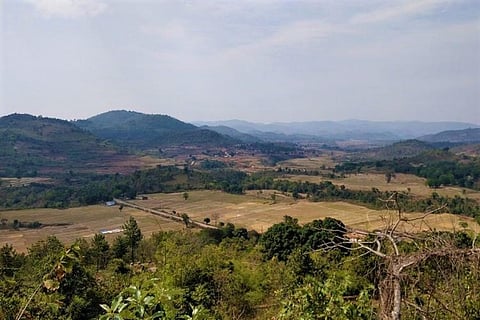

A week ago, the Andhra Pradesh cabinet set up a committee to work on the reorganisation of districts in the state. The committee has been tasked with carving new districts from the existing thirteen districts.
With reports suggesting that the reorganisation will result in 25 districts which might be coterminous with the 25 parliamentary constituencies in the state, concerns are being raised on how effective the division would be, in terms of increasing administrative convenience.
Tribal activists particularly, have objected to the division of the Agency areas or ITDAs (Integrated Tribal Development Agencies) into multiple districts, warning that this could lead to inconvenience for tribal populations and dilute their rights.
Ramarao Dora, Visakhapatnam District Convenor of the Adivasi Joint Action Committee (JAC), points out that the Araku parliamentary constituency alone has scheduled areas spread across four districts at present, falling under various ITDAs within those districts.
“In Araku constituency, the tribal areas protected under the Fifth Schedule of the Constitution, are spread across Srikakulam, Vizianagaram, Visakhapatnam and East Godavari districts at present and fall under various ITDAs. It is not practical to manage the administration if they are all brought under one district for Araku,” he says.
Madivi Nehru, Adivasi Sankshema Parishad co-ordinator from Bhadrachalam points out that when the districts in Telangana were reorganised in 2016, the mandals with tribal populations under ITDA Bhadrachalam were scattered across Khammam, Mahabubabad and Jayashankar Bhupalpally districts.
With this, Nehru says that people were inconvenienced. “When people have ITDA work, they have to come to Bhadrachalam. Here, the ITDA Project Officer has to forward it to the respective District Collector, based on which mandal the person is from. Ideally, when a District Collector is also the Chairperson of the ITDA, things are more efficient,” he says, adding that administrative reorganisation tends to be done keeping the convenience and interests of non-tribals in mind.
If the tribal areas are split into districts without proper care, there’s also a danger of scattering the tribal population and dilution of political assertion and rights, says Ramarao Dora.
Provisions like the Panchayats (Extension to Scheduled Areas) Act (PESA), and The Scheduled Tribes and Other Traditional Forest Dwellers (Recognition of Forest Rights) Act, (FRA), are likely to be diluted and easily violated, he adds.
“When scheduled areas are broken up, legal issues can crop up. For instance, in Telangana, Adilabad district was a stronghold for the Gond tribe. Now, Gonds are scattered in Nirmal, Komaram Bheem districts, and with this, there comes a danger of constitutional provisions being hurt,” says Ramarao Dora.
A statement issued by the Human Rights Forum (HRF) on the issue also notes that proper care must be taken while forming new districts in the scheduled regions so as to avoid “a lot of non-tribals entering the area, since this will be to the detriment of adivasis.”
“Three years down the line, in the newly constituted tribal districts in Telangana, there is a disquieting trend of non-adivasi business and real estate interests making forays into tribal villages,” the statement from HRF says, adding that there is a similar fear in scheduled areas of Andhra Pradesh, that an influx of non-tribal population may result in land grabbing and other such acts that may hurt the rights of Adivasis.
Nehru concurs, noting that the migration of non-tribals in the Chintoor ITDA area along the East Godavari and Khammam border has led to many land occupation issues in the region.
Ramarao Dora says that demands to de-schedule these areas may arise, while Nehru notes that employment benefits meant for district locals could also be lost.
“ITDAs are meant for protecting tribal areas and tribal peoples’ rights. What tribals need protection is from non-tribals -- from their exploitation and dominance. When ITDAs are broken down, this protection is also diluted. There can be a lot of administrative hurdles which can delay the process of infrastructure development, poverty alleviation and even the delivery of employment benefits,” Nehru says.
In its statement, HRF called the idea of making districts coterminous with parliamentary constituencies “impractical” and “devoid of rationality.”
HRF pointed out that Telangana, with an area of 1,12,077 square kms, has been carved into 33 districts. Andhra Pradesh, with a larger area of 1,60,205 square kms, must consider dividing existing districts into 3 to 4 new districts for administrative convenience, while according preference to backwards regions, and “keeping in mind proximity and geographical contiguity.”
Ramarao Dora suggests that each ITDA be converted into a district, or into an autonomous district council under the sixth schedule of the Constitution, as in the North-Eastern states.
“If there is an autonomous council, provisions like PESA Act and other measures meant to safeguard our rights and promote self-governance will be strengthened,” he says.
At present, there are nine ITDAs in Andhra Pradesh, headquartered in various places including Rampachodavaram of East Godavari district, Seethampeta of Srikakulam district, Paderu of Visakhapatnam district, Chintoor in East Godavari and Parvathipuram in Vizianagaram among others.